The year 2020 presented more challenges than many businesses have faced since their inception. For organizations that have been moving slowly on digital transformation (or ignoring it altogether), the coronavirus pandemic and ensuing lockdown have amounted to an extended wakeup call. Now that leaders have had a chance to look back at what happened, how they responded, and what the results were (and continue to be), they can approach the question “Where do we go from here?”
For many organizations, the issue is bigger than optimizing use of their technology budgets or gaining an edge on their competitors. It’s about how to best serve their customers even when circumstances throw “business as usual” out the window.
The coronavirus pandemic has made it clear to customer service organizations that relying primarily on 1:1 agent voice support does not offer the flexibility needed to respond to disruption. Those who have been slow to adapt technologies such as messaging, robotic process automation (RPA), self-service applications, and advanced IVR are recognizing the need to build a more resilient, adaptable model that makes optimal use of all available resources.
A moment of truth for contact centers
Back in March, we took a preliminary look at the impact of coronavirus on contact centers, which amounted to a “perfect storm” involving a surge in incoming calls at the same time as agents were forced to work from home due to virus-related health and safety protocols.
One organization shared with us that on one day in March, wait times averaged 90 minutes, with some extending as long as 7 hours, and the volume of call resolutions dropped to near zero. Their wait times continued to hover well above pre-coronavirus levels for months afterward.
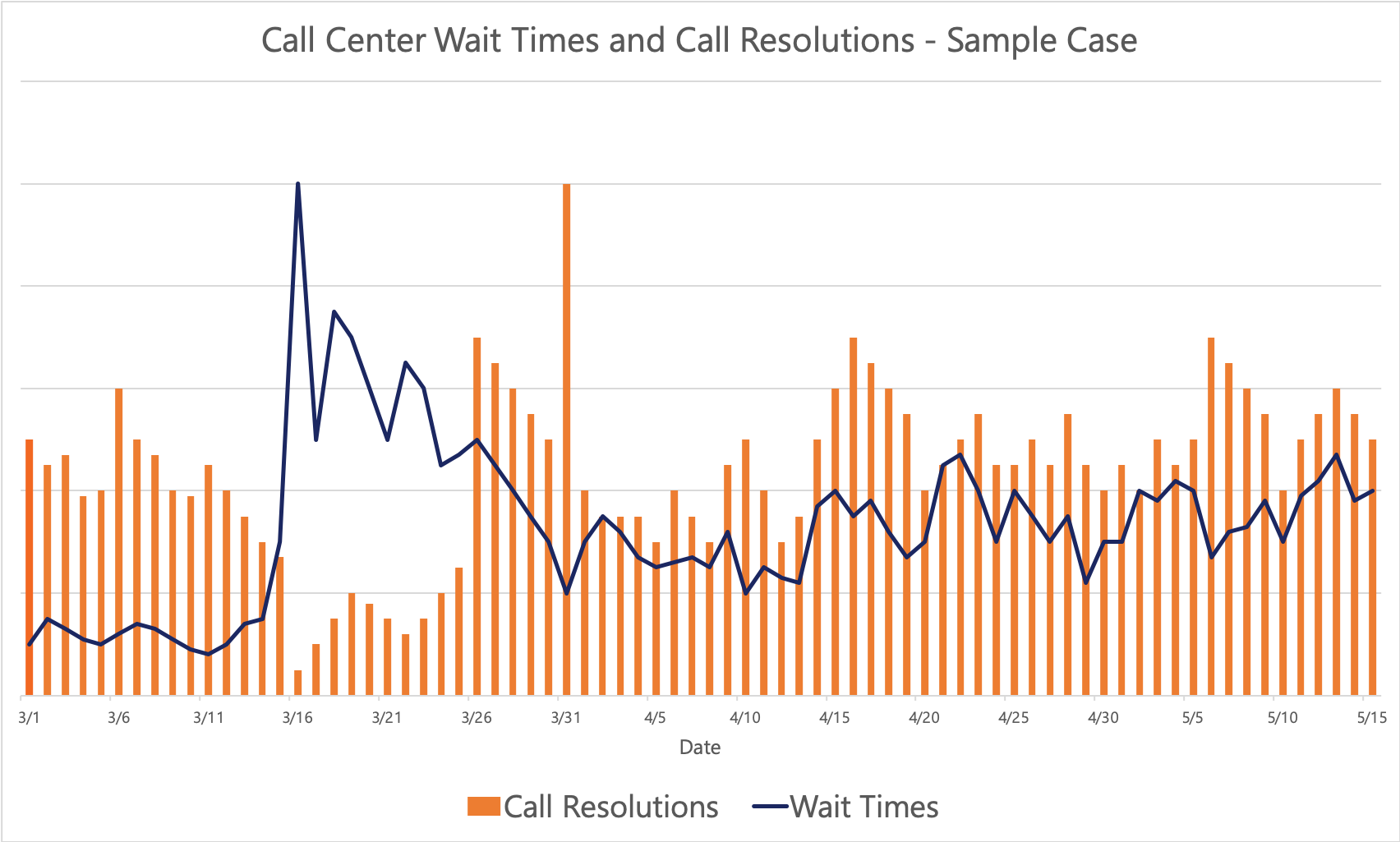
What can we take away from this organization’s experience? Three things:
- When a business reacts to disruption rather than proactively preparing for it, the results can be dramatic and enduring. Without alternative options for a zero-touch customer experience, contact centers will quickly be overwhelmed by post-call updates and fulfillment activities.
- Crises are rarely one-dimensional. The coronavirus crisis is a multifaceted disruption that combines decreased capacity with a spike in demand for service. This can detrimentally affect the First Contact Resolution (FCR) metric that is critical to managing capacity.
- Recovery will take longer than you think. Even two months after the mid-March spike, average wait times remain well above normal, and this can be seen clearly in depressed Net Promoter Score (NPS) metrics.
COVID-19 brought contact centers face-to-face with the limitations of traditional “voice only” or even “voice first” approaches. For organizations looking to maintain customer loyalty and preserve their competitive edge, there is no going back to the way things were before, at least not entirely.
Is doing nothing really an option?
As contact centers look ahead to plan their post-pandemic future, they find themselves facing a dilemma. On one hand, the crisis has placed a spotlight on the need to invest in digital transformation. On the other, the economic downturn has forced many budgets to shrink, and even if the dollars are available, there is no clear roadmap for how to prepare for the next crisis.
Faced with this conundrum, contact centers have three options:
- Do nothing — return to their pre-pandemic way of doing business.
- Optimize their existing infrastructure for greater flexibility and resilience.
- Execute a paradigm shift and invest in self-service and automated solutions.
While the “null hypothesis” (i.e., doing nothing) can present an attractive option given current constraints, contact center leaders have an opportunity to develop creative solutions that leverage technology to benefit customers and optimize the use of resources without requiring massive budgetary outlays.
The future of capacity management
The coronavirus pandemic forced contact centers to rethink their approach to capacity management, the space between the call volume they can handle and actual demand levels. The combination of a spike in demand and decreased capacity created a crisis situation that could easily happen again, and organizations must be ready.
The issue of scaling capacity cannot be solved simply by throwing money at it. Customer care leaders must think in terms not only of how to handle a surge in volume, but how to handle it cost-effectively while still delivering the quality service their customers deserve.
All contact centers have a limited number of ports for handling voice calls, with each port capable of connecting one customer to one agent at any given time. Once those ports reach capacity, the traditional approach is to place the customer in a wait queue until an agent becomes available. In today’s environment, where customers expect immediate resolution, long wait times can spell disaster. The limitations of their voice call capacity, coupled with the high cost of adding new ports, is driving organizations to think creatively about alternative approaches in providing prompt customer service even under the most challenging circumstances.
While no one foresees voice-based customer service going away anytime soon, more organizations are viewing it as one solution among many and considering the optimal configuration for their needs. Some of those alternate solutions include:
RPA
As we discussed in our previous Insight, robotic process automation (RPA) offers self-service capabilities to reduce call volume by up to 50 percent and improve first contact resolution, reducing the burden on agents. Robots can also handle post-call updates and fulfillment activities, delivering faster results to customers, freeing agents to assist more people, and reducing handling time by up to 40 percent. Because RPA sits on top of existing systems, it has the advantage of being unintrusive, offering organizations a manageable and cost effective first step in their journey towards greater resilience.
Alternative service channels
The consumer trend towards a greater reliance on technology, and the heightened expectations of service that accompany it, began long before the year 2020. The pandemic has taken this trend to a new level, particularly for industries that are deeply impacted, as people regularly turn to self-service applications for socially-distanced tasks ranging from ordering groceries to attending work meetings. For office workers who find themselves working from home for the long-term, instant messaging platforms are now an essential element of day-to-day communications. While these technologies are nothing new, their increased use during the pandemic has heightened consumers’ appetites for immediate gratification.
These trends are forcing contact centers to think beyond their “voice first” approach to customer service and begin building a flexible portfolio of alternative service channels:
- Messaging platforms can expedite customer service in two ways: by routing simple requests to virtual assistants and/or by allowing agents to handle multiple live conversations simultaneously.
- By expanding their portfolios of self-service options — via their websites, mobile applications, SMS, and/or social channels — organizations can empower customers to solve their own problems and access the information needed to make decisions about their accounts.
- Advanced interactive voice response (IVR) systems allow organizations to offer callers the options of
- Scheduling a call for a future time
- Leaving a voicemail and receiving a call back
- Anticipating customer needs and directing them to a different platform
- Accessing AI-based virtual assistants using voice recognition technology to process simple requests
In the pre-pandemic world, many organizations relied primarily on 1:1 agent phone support, which may have been perfectly feasible for their normal day-to-day operations. The rapid, sweeping changes ushered in by the coronavirus highlighted the need for alternative models to fall back on when unexpected events turn “business as usual” on its head. The customer care model of the future reallocates the priority of its various channels as needed to optimize its response to customer needs with maximum flexibility.
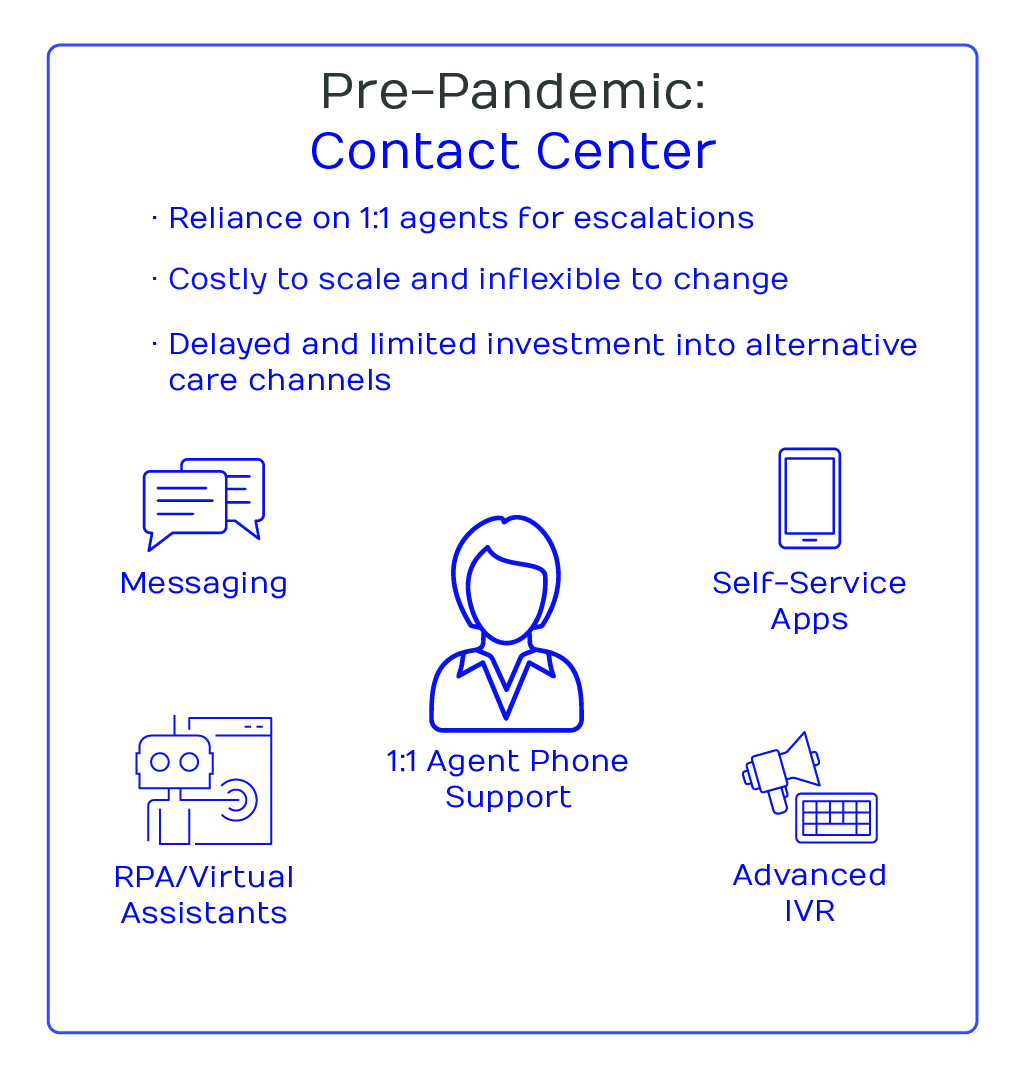
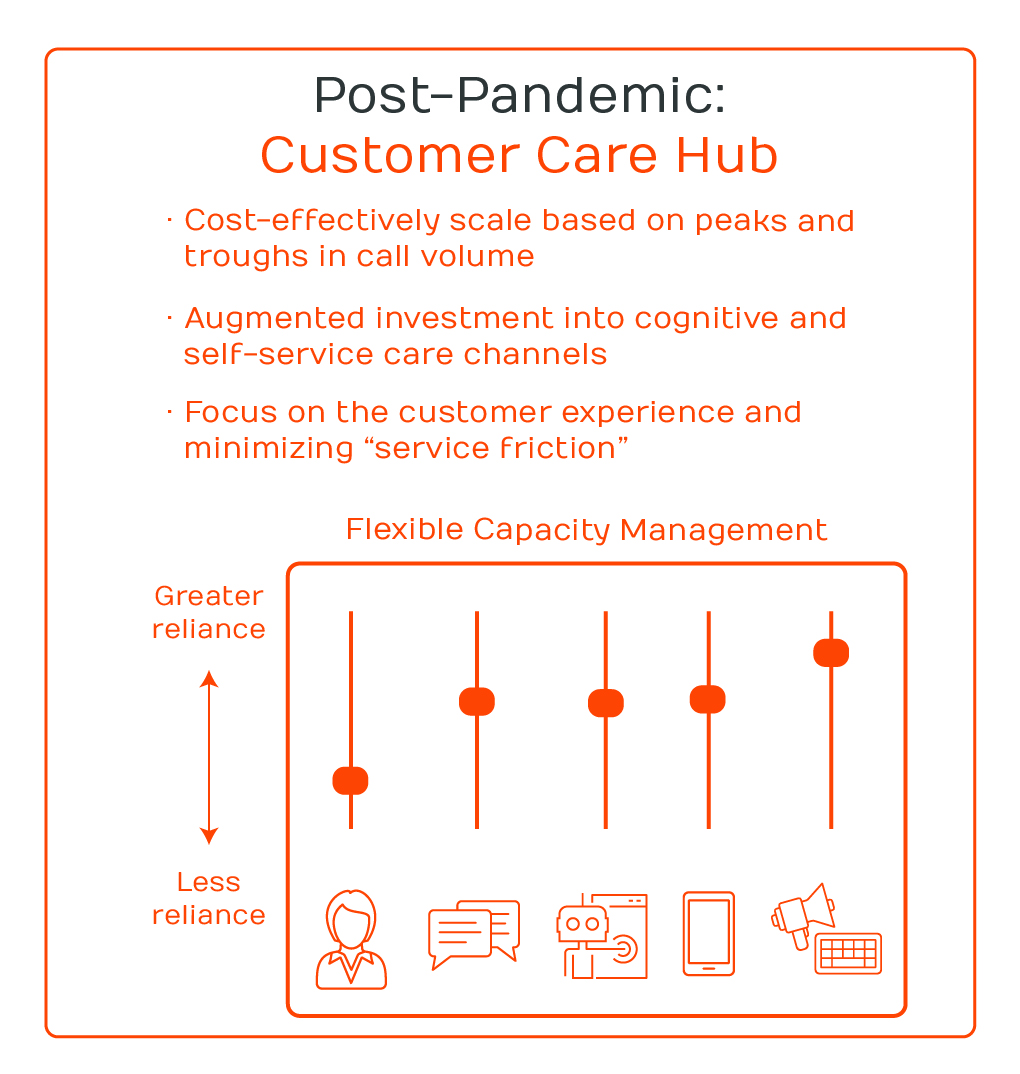
A zero-touch, friction-less customer experience
If you go searching on some websites for a catch-all 1-800 customer care phone number, you won’t find one. Many organizations have moved away from one-call customer service in favor of an immersive experience that proactively identifies what customers need, offers them customized options, then leverages AI, NLP, NLG, and other technologies to deliver the most efficient service according to the customer’s needs and preferences.
For example, the Apple website offers different customer care options depending on the customer’s device and issue:
iPhone
- Request a call from Support now
- Schedule a call from Support for a later time
- Submit details online and call Support later
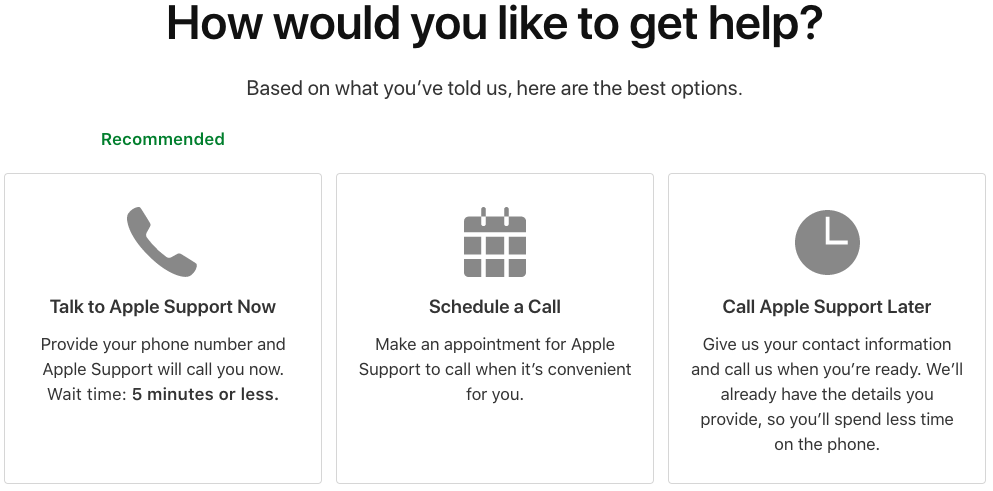
MacBook
- Submit details online and call Support later
- Bring in for repair (find an authorized service provider or make an appointment at the Genius Bar)
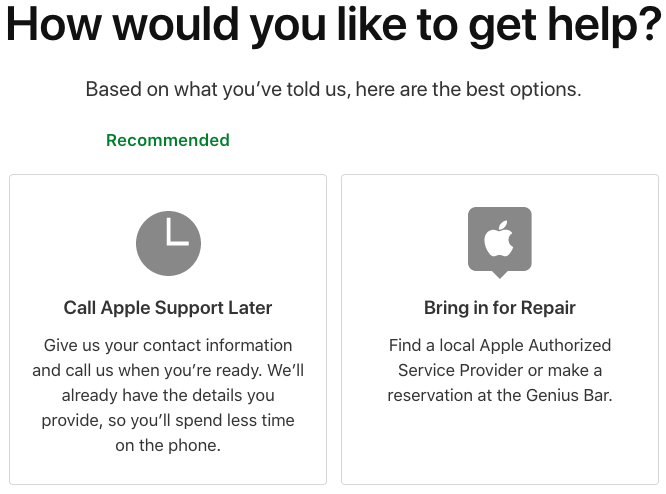
App Store
- Request a refund online
- Send an email to Support
- Schedule a call from Support for a later time
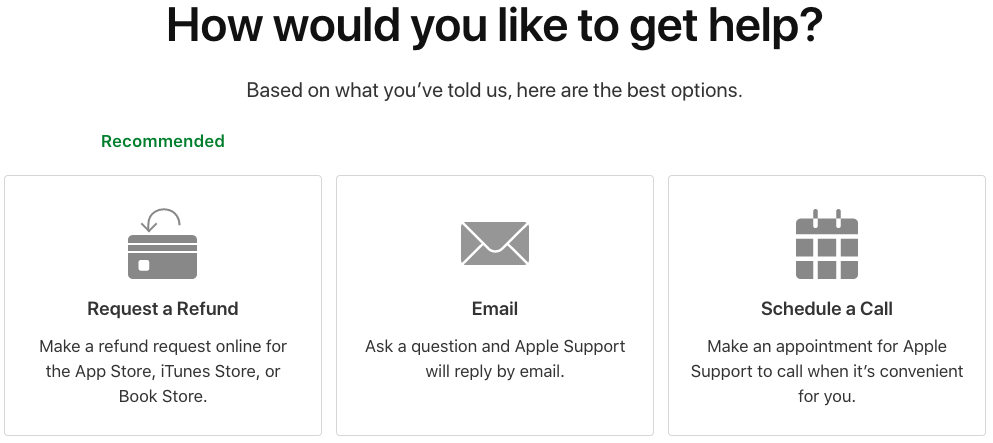
Welcome to post-pandemic customer care
“Change is the law of life. And those who look only to the past or present are certain to miss the future.”
– John F. Kennedy
While it will take years to comprehend the full impact of the coronavirus on the business world, it’s clear that “business as usual” is taking on a very different meaning. It would be naïve for organizations to think of the current crisis as a once-in-a-lifetime occurrence and go back to the old way of doing things once it has passed. What the new normal will look like is anyone’s guess, but at the heart of the question is one of the oldest concepts in business that still rings true today: keep your customers at the center of all you do, and everything else will fall into place.
Like what you see?

Amit Unadkat is a Manager of Digital Transformation with extensive experience in robotic process automation, virtual assistants, business process optimization, and technical product management.

